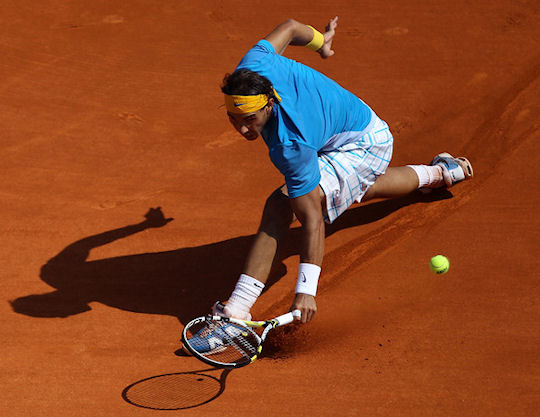 |
| Djokovic captured the title this year. |
The first Grand Slam of this year was all about one person, and one person only. Novak Djokovic succeeded in finally reclaiming his Australian Open singles title, three years after capturing his first one Down Under. This was a huge accomplishment in itself, but what was even more incredible was the way in which he ran through the draw, dropping only one set in the process to Ivan Dodig of Croatia. This "Djokovic" was nothing like the man that won in 2008. Then, Djokovic was a teenager, prone to unpredictable results, struggling with his serve, and succumbing to nerves. This time around, the man from Serbia showed his mental fortitude and unbelievable defense throughout the fortnight.
And it's not as if Djokovic's title was a fluke. He had to fight through constant threats such as Almagro, Berdych, Federer, and Murray. He also wasn't a favorite coming in. But Novak powered through these roadblocks without so much as a hiccup. This, in turn, led to his inspirational graduation out of the "One-Slam Wonder" club.
 |
| Nadal's exit came to David Ferrer. |
Rafael Nadal's quest to become the first man to hold all four majors at once since Rod Laver in 1969 ended in bitter disappointment this year, as he bowed out against the feisty David Ferrer in straight sets. In a marathon 18+ minute second game, Nadal seemed to have injured his muscle (it was later confirmed to be a small hamstring tear).
From then on, he was nowhere near his best, letting Ferrer dictate the majority of the rallies. He was out of sorts during the entire 6-4, 6-2, 6-3 beat-down. Nadal was, as always, classy in defeat. He congratulated Ferrer continuously in his press conference. But the lingering question of Nadal's future hangs in the air: How long will it be before his body simply won't be able to support his physically taxing game any longer?
 |
| Federer's forehand let him down. |
Roger Federer's Australian Open attempt was not unlike Rafa's. He came in as a favorite. And, more importantly, he was dismissed in straight sets. But the major difference between these conflicting story lines was that Federer appeared to be playing his game. While Nadal was clearly fighting the effects of a lingering virus and a tear to his hamstring, Federer came in with fine form. After his U.S. Open semifinal loss to Djokovic, Federer looked nearly invincible for the remainder of last year. He compiled a 16-2 record with losses only to Andy Murray in Shanghai and to Gael Monfils in Paris. So no one could be faulted for expecting a final appearance from the Swiss Maestro. However, things did not turn out to be so clear. In a tough second round matchup against Gilles Simon of France, Federer became flat up two sets to none. His forehand began to fall apart, and the match went five sets. After the grueling match with the Frenchman, Federer's disinterest seemed to continue recurring in his game. At times when playing Xavier "X man" Malisse, Federer appeared disinterested, making several disastrous errors. When it really mattered, these little mistakes led to a loss to Djokovic.
 |
| Soderling had his best Aussie Open to date. |
Robin Soderling has never enjoyed relative success at the Australian Open. Overall, it has been his worst Grand Slam. This year around, however, everything seemed to be going for him. He was the highest he'd ever been seeded in a Slam, at 4th, and his draw was considerably favorable. In his first three matches, he dominated. He appeared to be the key person in disrupting the Federer-Nadal dream final. In a tricky match against the talented Ukrainian, Alexandr Dolgopolov, Robin's serve, which had been his greatest asset the entire tournament, fell apart. So did his chance to get to the quarterfinals. He bowed out in five unusually quick sets.
 |
| Murray was an underdog. |
Andy Murray came into the Australian Open without being on the radar. All the talk was of Nadal's possible Grand Slam and Federer's strong play. So much focus was put on this possible final that Andy Murray, the finalist exactly a year ago, was not the topic of conversation. But he came in strong. His serve was a weapon and his movement was exceptional. He had straightforward matches at first with players that couldn't really challenge him, like Garcia-Lopez and Jurgen Melzer. The fact is, Murray was dominating his matches until he came up against the 22-year-old upstart Dolgopolov. Murray was truly in for a fight. But he emerged victorious. By the semifinals, the draw had opened up with Nadal's elimination. And so, the light had again turned to Murray. With this new pressure on his shoulders, Andy struggled with the force of Ferrer's play, and played much of the match from far behind the baseline. He came within a point of being two sets down to love. Somehow, he pulled out the victory 4-6, 7-6, 6-1, 7-6. Once again though, his passive game showed through when he played the final. Djokovic didn't give Andy even the slightest of openings, unlike his previous opponents. His anger eventually got the best of him, and it was a highly unsatisfying performance.
And so, another Australian Open has come and gone. Many twists and surprising results dotted the field. Newcomers emerged, stars bowed out, and five-setters dominated the field. The tournament has left us all in eager anticipation for the next Grand Slam, Roland Garros.
Is it really another four months until then?











